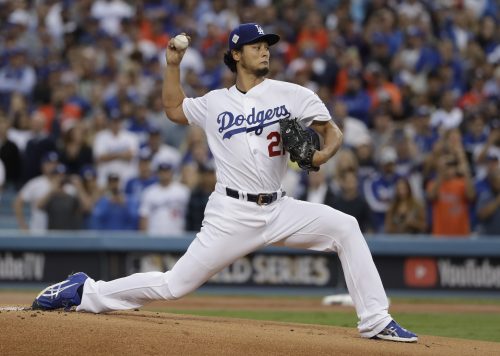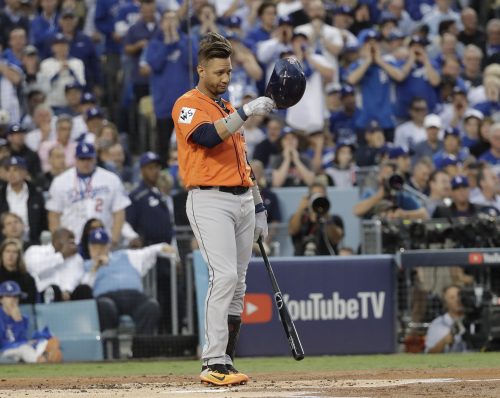After Houston Astro’s first basemen Yuli Gurriel escaped a World Series suspension for a racist gesture toward the Los Angeles Dodger’s Japanese pitcher Yu Darvish, the fans at Minute Maid Park in Houston, Texas welcomed Gurriel to the plate with a standing ovation.
Just a few days later, when the series returned to Los Angeles, Gurriel was showered with boos from every corner of Dodger Stadium.
The vehement disapproval of Gurriel’s actions was to be expected in Los Angeles, but the warm reception in Houston raised eyebrows. It’s hard to imagine Astro fans were making a direct celebration of the first-baseman’s racist gesture, but a standing ovation doesn’t exactly scream disapproval — in fact, it can feel a lot like the opposite.
Standing ovation is derived from the Latin word ovatio, or ‘exult,’ according to the definition cited in Merriam-Webster. Romans would stand to give an ovation to a general who had not won, but who deserved the honor of being acknowledged for having fought valiantly. Standing ovations naturally seeped into other realms of public gatherings.

(Matt Slocum/AP Photo)
Historically, the most notable event where a standing ovation takes place is within the theater scene. The roots take ahold in the crowd’s notion that they had unanimously seen something that left them in awe. A truly great performance in the theater has the audience standing for an applause to acknowledge the talent. Mainstream Broadway shows have taken the act of occasional praise and turned standing ovations into an obligatory part of the evening’s events.
The act of standing ovations has bled into entertainment events such as concerts, political conventions, public speaking events and concerts. Concert goers have become accustomed to the artists ending their sets, and after the crowd stands and chants for an ovation, the artist comes back out for a few more ballads.
“I always think that an artist will come back out for another song, and I get mad when they don’t,” student Amyia Brooks said.
The sets have been timed for these standing ovations, and the nuance and specialty of these moments have become diluted by preconceived expectations.
Standing ovations in the theater versus standing ovations in sports differ greatly.
“Where as it might be out of line for a theater where there is more of a code of decorum, sports allows you to let loose,” David Haugh, sports columnist at The Chicago Tribune, said. “It is a part of the genre, atmosphere and a part of why people want to be in that environment–anything goes.”
Graduate student Nick Johnson believes that standing ovations in baseball are most often encouraging moments.
“Standing ovations in baseball could be anywhere from the starting pitcher coming out of the game who has been dealing for the last eight innings, one run–you obviously don’t see that a lot so you are going to see fans stand up and applaud him for that,” Johnson said. “Or you get standing ovations for players like Altuve. Fans can appreciate a player who has gone through all the hard work that they put you through in the off-season, and to see that work culminate on the field—the fans are just trying to appreciate the guy.”
However, in lieu of current sporting events, standing ovations have acted as a mirror that reflects the great divide within the bipartisanship country. Among many stories in sports news, two incidents in different professional leagues struck a similar chord.
On Oct. 28, The National Football League’s Seattle Seahawk’s fans gave a standing ovation during the national anthem in support of the Houston Texans’ players taking a knee. The Texans taking the knee was in response to the Texans’ owner Bob McNair’s remark on “inmates running the prisons.” According to The Seattle Times, nine of the players stood for the anthem, but more than 40 chose to take a social stance by taking the knee. Out of 100,000 people, 765 white citizens are incarcerated and 2,855 black citizens are incarcerated in Texas, according to the 2010 U.S. Census

(David J. Phillip/AP Photo)
“It is healthy whenever people examine why they do what they do,” Haugh said. “I am all for professional athletes having a more vested interest in the way the world works beyond the 53-yard by 120-yard rectangle they would play on every Sunday or the basketball court, or the baseball field.”
During the 2017 World Series between the Los Angeles Dodgers and the Houston Astros, Houston fans gave Gurriel a standing ovation when he went up to bat during game four of the World Series. This is following his racist slanted-eye gestures towards the Los Angeles Dodgers pitcher Darvish during game three after Gurriel batted a home-run. In this instance, baseball fans found the standing ovation in support of Gurriel to be in support of his insensitive behavior. Some audience members stood in support of the racial actions, but most were cheering about the MLB’s decision to not suspend Gurriel until next season for his behavior. Even if this was the case, it was hard for baseball fans to digest.
When game six brought the series to Los Angeles, the crowd was prepared to stand—not for an ovation of praise, but to show their frustration. As Gurriel walked up to bat, fans in the stadium broke out in a standing chorus of boos. Dodgers pitcher Rich Hill stepped off the mat to let the statement resonate just a little bit longer.
“Everyone starts noticing what is going on here, and then it becomes a thing,” Haugh said. “Ten seconds becomes 20 seconds becomes 30 seconds, and then next thing you know Rich Hills is stepping off the mount and it is a statement. The best standing ovations begin as reactions and they end as statements.”
The similarity between the LA Dodgers and the Houston Astros and the Seattle Seahawks and the Houston Texans is the reaction from two different leagues from the same town, Houston. The Houston Texans NFL players were taking a knee during the anthem to protest their coach’s insensitive comment about inmates. The coach’s comment reinforced social and racial stigmas, and it spoke to the ignorance of his white privilege. However, the same city’s MLB team had a player display racial hand gestures towards an opposing teams’ player of Asian descent. After the Houston Astros teammates gesture, during the next game the Astros fans gave him a standing ovation as he walked up to bat. Did the love for winning overcome the fact that he made a racially charged gesture, or does the division within Houston model what is happening across the country?
“Different parts of the country have different reactions to this issue, which is America. It is not just the NFL (or MLB), it is Chicago and it is your neighborhood block,” Haugh said. “They may either love the Anthem protests or they may hate it, but whatever it is, a consensus starts to build.”

